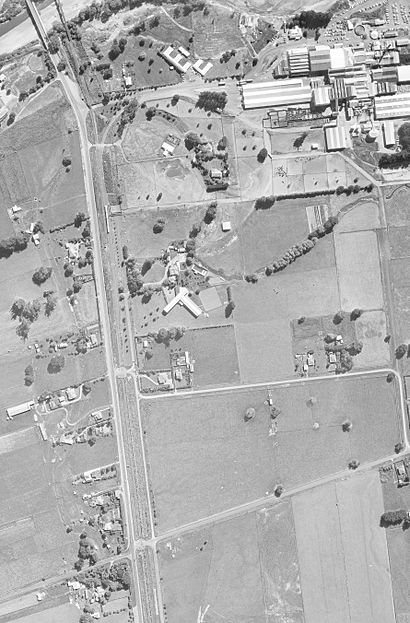Aorangi railway station facts for kids
Quick facts for kids
Aorangi railway station
|
|||||||||||
|---|---|---|---|---|---|---|---|---|---|---|---|

Aorangi in 1967, showing the bridge over the Oroua, meat works, sidings and possible site of station shelter
|
|||||||||||
| Location | New Zealand | ||||||||||
| Coordinates | 40°14′36″S 175°35′06″E / 40.243305°S 175.585032°E | ||||||||||
| Elevation | 70 m (230 ft) | ||||||||||
| Owned by | KiwiRail | ||||||||||
| Line(s) | North Island Main Trunk | ||||||||||
| Distance | Wellington 150.9 km (93.8 mi) | ||||||||||
| Platforms | 1 | ||||||||||
| History | |||||||||||
| Opened | 1 October 1876 | ||||||||||
| Closed | 2 November 1987 | ||||||||||
| Electrified | 25 kV 50 Hz AC June 1988 | ||||||||||
| Services | |||||||||||
|
|||||||||||
The Aorangi railway station was a small train stop in New Zealand. It was located on the important North Island Main Trunk railway line.
The station first opened in 1878. It stopped serving passengers on August 10, 1959. Later, it closed completely for goods traffic on November 2, 1987. Today, only a single railway line runs through where the station used to be. The Te Araroa long-distance walking trail passes right by the old station site.
Contents
History of the Aorangi Station
By July 1876, the railway tracks were ready. They connected the towns of Palmerston North and Feilding. The official opening of this railway line was on October 19, 1876.
A man named Charles Bull had a sawmill near Aorangi until about 1886. His sawmill had its own private railway siding from 1878. A siding is a short track used for loading or unloading goods. In 1883, people complained that trains were not stopping for passengers at Aorangi.
By 1896, the station had a shelter shed and a platform for passengers. By 1911, there was also a way for carts to approach the station.
In 1959, the station still had a shelter and a platform. There was also a private siding for Borthwicks' meat works. This siding was the only reason trains still stopped there after the station closed for passengers. An old photo from 1949 seems to show a shelter. The 1967 photo (shown in the infobox) also has a white mark that might be the shelter. In 1989, the station site still had a passing loop and the private siding. A passing loop is an extra track that allows trains to pass each other.
The Aorangi Bridge
The railway line crosses the Oroua River between Aorangi and Feilding. It does this on a bridge called the Aorangi Bridge. This bridge was rebuilt between 1930 and 1931. During the rebuilding, the curve of the track was made smoother.
The bridge is very long, measuring about 183 m (600 ft). It has ten sections, each about 60 ft (18 m) long.
A separate footbridge for people to walk across the river was built in 1883. The first road bridge opened on March 21, 1893. This road bridge was later replaced in 1930 with a new one made of ferro-concrete.
Both the road and railway bridges were partly washed away by a big flood on April 17, 1897.
The Freezing Works and Rail Traffic
A "freezing works" is a factory where meat is processed and frozen. A railway siding was built for the Oroua Freezing works in 1915. This allowed trains to bring animals and take away frozen meat.
The West Coast Meat & Produce Co Ltd officially opened the works on April 17, 1916. The Prime Minister, Bill Massey, was there for the opening. Later that year, the company changed its name to Feilding Farmers’ Freezing Company Ltd.
In 1931, the works were sold to Thomas Borthwick and Sons (Australasia) Ltd. This company even had a small shunting locomotive at Aorangi from 1931 to 1973. A shunting locomotive is a small train used to move railway cars around the factory area.
In 1944, the amount of goods carried by rail started to decrease. This was because trucks were allowed to carry goods by road for up to 20 mi (32 km) alongside the railway.
The freezing works became part of AFFCO in May 1992. This happened after the factory was rebuilt in September 1991. Today, the works are no longer connected to the railway line.
Images for kids


